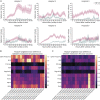Neurophysiology State Dynamics Underlying Acute Neurologic Recovery After Cardiac Arrest
- PMID: 37414565
- PMCID: PMC10501085
- DOI: 10.1212/WNL.0000000000207537
Neurophysiology State Dynamics Underlying Acute Neurologic Recovery After Cardiac Arrest
Erratum in
-
Correction to Author Disclosures.Neurology. 2024 Dec 24;103(12):e210123. doi: 10.1212/WNL.0000000000210123. Epub 2024 Nov 21. Neurology. 2024. PMID: 39571126 Free PMC article. No abstract available.
Abstract
Background and objectives: Epileptiform activity and burst suppression are neurophysiology signatures reflective of severe brain injury after cardiac arrest. We aimed to delineate the evolution of coma neurophysiology feature ensembles associated with recovery from coma after cardiac arrest.
Methods: Adults in acute coma after cardiac arrest were included in a retrospective database involving 7 hospitals. The combination of 3 quantitative EEG features (burst suppression ratio [BSup], spike frequency [SpF], and Shannon entropy [En]) was used to define 5 distinct neurophysiology states: epileptiform high entropy (EHE: SpF ≥4 per minute and En ≥5); epileptiform low entropy (ELE: SpF ≥4 per minute and <5 En); nonepileptiform high entropy (NEHE: SpF <4 per minute and ≥5 En); nonepileptiform low entropy (NELE: SpF <4 per minute and <5 En), and burst suppression (BSup ≥50% and SpF <4 per minute). State transitions were measured at consecutive 6-hour blocks between 6 and 84 hours after return of spontaneous circulation. Good neurologic outcome was defined as best cerebral performance category 1-2 at 3-6 months.
Results: One thousand thirty-eight individuals were included (50,224 hours of EEG), and 373 (36%) had good outcome. Individuals with EHE state had a 29% rate of good outcome, while those with ELE had 11%. Transitions out of an EHE or BSup state to an NEHE state were associated with good outcome (45% and 20%, respectively). No individuals with ELE state lasting >15 hours had good recovery.
Discussion: Transition to high entropy states is associated with an increased likelihood of good outcome despite preceding epileptiform or burst suppression states. High entropy may reflect mechanisms of resilience to hypoxic-ischemic brain injury.
© 2023 American Academy of Neurology.
Conflict of interest statement
E. Amorim, W.-L. Zheng, J. Jing, M.M. Ghassemi, J.W. Lee, O. Wu, S.T. Herman, T. Pang, A. Sivaraju, N. Gaspard, L.J. Hirsch, B.J. Ruijter, M.C. Tjepkema-Cloostermans, and J Hofmeijer report no disclosures relevant to the manuscript. M.J.A.M. van Putten is founder of Clinical Science Systems. Clinical Science Systems did not contribute funding nor played any role in the study. M.B. Westover is a cofounder of Beacon Biosignals. Beacon Biosignals did not contribute funding nor played any role in the study. Go to
Figures






References
Publication types
MeSH terms
Grants and funding
LinkOut - more resources
Full Text Sources
Medical
Research Materials
